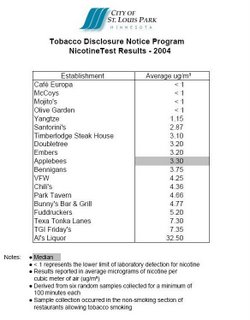Government conducted air quality test results for secondhand smoke coincide with what OSHA has repeatedly stated, "what health hazard?"
Rather than update this blog on a regular basis, the information on this weblog, especially these first two posts are designed to be reference material for those battling proposed smoking ban legislation. Clearing the Air regularly provides the government air quality data regarding secondhand smoke in the post below to lawmakers around the country, and we encourage anyone else who stumbles upon this page to also provide this air quality information to lawmakers in your respective districts. Many organizations with ties to pharmaceutical nicotine interests are providing misleading and exaggerated data to lawmakers to benefit their own particular interests.....it's time to balance out the information lawmakers receive so that they can make an informed, unbiased, and fair decision.In 2004 a municipal environmental health department quietly conducted air quality testing of secondhand smoke in all bars & restaurants in its jurisdiction. The purpose of this testing, no doubt, was to point out how hazardous secondhand smoke is. But what happens when that government air quality testing doesn’t support the pro-smoking ban agenda?
Air quality testing results:
Comparison of the St. Louis Park, MN. Environmental Health Department secondhand smoke air quality test results to OSHA guidelines, side by side:

Above is the partial OSHA table of permissible exposure limits, click to enlarge
1 milligram mg = 1,000 micrograms ug (full OSHA table can be found here)

Above is the St. Louis Park, MN. air quality test results of secondhand smoke concentrations click to enlarge (actual SLP results found here)
The upper table is the partial OSHA permissible exposure limit table (Standards - 29 CFR) for airborne contaminants ie. these levels are the safe exposure limits for humans. You'll note that the nicotine* safe level is 0.5 milligrams mg / cu. M (or 500 micrograms (ug) / cu. M).
The bottom table is the actual St. Louis Park test results for 19 establishments of measured airborne nicotine* levels during typical busy evenings. You can see the median establishment, Applebees, had a reading of 3.3 micrograms ug / cu. M.
Now let’s do the math, 500 ug (OSHA safe level) divided by 3.3 ug (median reading Applebees) = measured airborne nicotine* levels are 152 times safer than OSHA regulations. In other words NO HEALTH HAZARD as per OSHA workplace indoor air quality standards.
It is therefore disingenuous to implement smoking bans based on the argument that secondhand smoke is a health hazard, that argument has been scientifically proven false.
* (As per air quality researchers nationwide) Nicotine is the only unique or "trace" chemical in secondhand smoke. If you measured for formaldehyde, the carpet and other interior sources of formaldehyde would corrupt the test result, formaldehyde is formed naturally in our atmosphere due to photochemical oxidation. Benzene is given off from burning foods in the kitchen or diesel exhaust outdoors so again a false reading would be obtained. Therefore, nicotine is the ideal chemical to measure to determine secondhand smoke concentrations in the air. And then our comparison to OSHA guidelines is the logical manner in which to determine if secondhand smoke levels pose a health hazard, as you can see, according to OSHA, the authority on workplace safety, they do not. If you wanted you could measure every airborne chemical in secondhand smoke and then compare them to OSHA guidelines for each specific chemical, the results would be the same, if not more dramatic.
OSHA itself has stated regarding secondhand smoke:
"Field studies of environmental tobacco smoke indicate that under normal conditions, the components in tobacco smoke are diluted below existing Permissible Exposure Levels (PELS.) as referenced in the Air Contaminant Standard (29 CFR 1910.1000)...It would be very rare to find a workplace with so much smoking that any individual PEL would be exceeded."
-Letter From Greg Watchman, Acting Ass't Sec'y, OSHA, To Leroy J Pletten, PHD, July 8, 1997
Smoking cigarettes can be hazardous to the smoker, no argument there. However, secondhand smoke is not the deadly hazard pro-smoking ban groups claim. Which should lead one to question what is the real agenda, and why the hype?
And for the record, the answer to the original question:….what happens when the government air quality testing doesn’t support the pro-smoking ban agenda? It gets buried of course, never to see the light of day. As a matter of fact, the city which conducted the “nicotine disclosure” testing, recently removed these air quality test results from their website (probably under duress from certain pro-smoking ban groups). If it weren’t for backup copies on “Clearing the Air” servers here, and the St. Paul Pioneer Press archive, the facts from this study would simply ……….go up in smoke.
Ventilation options do work, government air quality testing proof is here.
Support our sponsor.Mark Wernimont



 "Though we may not be able to protect your business property rights, we certainly support your Second Amendment Rights"
"Though we may not be able to protect your business property rights, we certainly support your Second Amendment Rights" 

<< Home